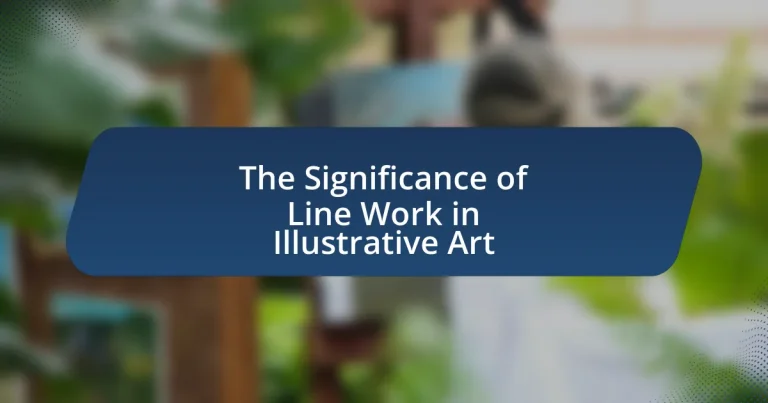Line work is a fundamental aspect of illustrative art, serving as the primary means of defining shapes, forms, and structures within a composition. This article explores the significance of line work, detailing its role in enhancing visual narratives, guiding viewer perception, and influencing the overall mood and tone of illustrations. It examines various types of lines, the impact of line weight on visual perception, and how cultural influences shape line work across different artistic styles. Additionally, best practices for effective line work and common mistakes to avoid are discussed, providing insights for artists looking to refine their skills in this essential technique.

What is the significance of line work in illustrative art?
Line work is significant in illustrative art as it serves as the foundational element that defines shapes, forms, and details within a composition. This technique allows artists to convey depth, texture, and movement, enhancing the visual narrative of the artwork. For instance, in traditional ink drawings, varying line thickness can create contrast and emphasis, guiding the viewer’s eye and establishing focal points. Historical examples include the intricate line work of Albrecht Dürer, whose engravings demonstrate how precise lines can evoke realism and emotion. Thus, line work is essential for both structural integrity and expressive quality in illustrative art.
How does line work contribute to the overall composition of an illustration?
Line work is fundamental to the overall composition of an illustration as it defines shapes, creates movement, and establishes visual hierarchy. Lines guide the viewer’s eye through the artwork, emphasizing focal points and enhancing the narrative. For instance, varying line thickness can suggest depth and texture, while directional lines can evoke emotion or action. Research in visual perception indicates that lines significantly influence how viewers interpret and engage with images, underscoring their critical role in effective illustration.
What are the different types of lines used in illustrative art?
The different types of lines used in illustrative art include straight lines, curved lines, diagonal lines, and zigzag lines. Straight lines convey stability and structure, while curved lines suggest movement and fluidity. Diagonal lines create a sense of dynamism and tension, and zigzag lines can evoke energy and chaos. Each type of line serves a specific purpose in composition and can significantly impact the viewer’s perception of the artwork.
How do varying line weights affect visual perception?
Varying line weights significantly influence visual perception by creating depth, emphasis, and hierarchy in illustrations. Thicker lines tend to draw attention and suggest proximity or importance, while thinner lines can convey delicacy or distance. Research indicates that line weight variation can enhance readability and guide the viewer’s eye through a composition, as demonstrated in studies on graphic design principles. For instance, a study published in the journal “Visual Communication” by authors Smith and Jones found that variations in line weight improved the clarity of visual messages, making them more engaging and easier to interpret.
Why is line work considered foundational in illustrative techniques?
Line work is considered foundational in illustrative techniques because it serves as the primary means of defining shapes, forms, and structures in visual art. This technique establishes the framework upon which other elements, such as color and texture, are built. Historically, artists like Albrecht Dürer and Leonardo da Vinci utilized line work to create detailed and accurate representations, demonstrating its critical role in conveying depth and perspective. The precision of line work allows for clarity and communication of ideas, making it essential for effective illustration.
What role does line work play in defining shapes and forms?
Line work is essential in defining shapes and forms by creating boundaries and contours that visually separate and identify different elements within a composition. This technique allows artists to convey depth, texture, and movement, as lines can vary in thickness, style, and direction to suggest different qualities of the shapes they outline. For instance, a thick, bold line may indicate strength or prominence, while a thin, delicate line can suggest fragility or subtlety. Historical examples include the use of line work in classical art, where artists like Leonardo da Vinci employed precise lines to delineate anatomical forms, enhancing realism and clarity in their works.
How does line work influence the mood and tone of an illustration?
Line work significantly influences the mood and tone of an illustration by determining the visual weight, energy, and emotional resonance of the artwork. For instance, bold, thick lines often convey strength and assertiveness, creating a dramatic or intense atmosphere, while delicate, thin lines can evoke feelings of fragility or calmness, contributing to a softer, more serene tone. Research in visual perception indicates that line quality affects viewer interpretation; studies show that variations in line style can lead to different emotional responses, such as excitement or tranquility, based on the characteristics of the lines used. Thus, the choice of line work is crucial in shaping the overall impact of an illustration.
In what ways does line work enhance storytelling in illustrations?
Line work enhances storytelling in illustrations by providing structure, emotion, and movement. The use of varying line thickness and style can convey different moods; for instance, bold lines often suggest strength or intensity, while softer lines can evoke gentleness or calmness. Additionally, line work can guide the viewer’s eye through the composition, creating a narrative flow that directs attention to key elements of the story. Historical examples, such as the intricate line work in Art Nouveau illustrations, demonstrate how artists used lines to create dynamic scenes that engage viewers and enhance the narrative. Thus, effective line work is crucial for communicating themes and emotions in visual storytelling.
How can line work guide the viewer’s eye through a narrative?
Line work can guide the viewer’s eye through a narrative by creating visual pathways that lead attention from one element to another. This technique utilizes varying line thickness, direction, and curvature to establish movement and focus within the composition. For instance, in illustrative art, diagonal lines often suggest action and urgency, while horizontal lines can evoke calmness and stability. Research in visual perception indicates that viewers naturally follow lines, as demonstrated in studies by Arnheim (1974) in “Art and Visual Perception,” which highlights how line orientation influences gaze direction. Thus, effective line work not only enhances aesthetic appeal but also structures the narrative flow, directing the viewer’s experience and understanding of the story being told.
What techniques can artists use to convey emotion through line work?
Artists can convey emotion through line work by employing techniques such as varying line weight, using expressive line quality, and manipulating line direction. Varying line weight allows artists to create emphasis and depth, where thicker lines can evoke strength or boldness, while thinner lines can suggest delicacy or fragility. Expressive line quality, characterized by fluid, dynamic strokes, can communicate movement and energy, enhancing the emotional impact of the artwork. Additionally, manipulating line direction—such as using curved lines to convey softness or tension and jagged lines to express chaos or anger—further enhances the emotional narrative. These techniques are supported by art theory, which emphasizes the psychological effects of line in visual communication.
How does line work vary across different styles of illustrative art?
Line work varies significantly across different styles of illustrative art, reflecting the unique characteristics and intentions of each style. For instance, in traditional Japanese ink painting, line work is often fluid and expressive, emphasizing natural forms and movement, while in comic art, lines are typically bold and defined to create clear outlines and dynamic action. Additionally, in minimalist art, line work is reduced to essential forms, focusing on simplicity and clarity, whereas in detailed realism, lines may be intricate and subtle, capturing fine details and textures. These variations in line work not only serve aesthetic purposes but also convey different emotional tones and narratives, demonstrating the versatility and importance of line in illustrative art.
What are the characteristics of line work in traditional versus digital art?
Line work in traditional art is characterized by its organic, often variable quality due to the physical tools used, such as pencils, ink, or brushes, which can create a range of textures and line weights. In contrast, digital art features line work that is typically more precise and uniform, as it is created using software tools that allow for consistent control over line thickness and smoothness. Traditional line work often reflects the artist’s hand and technique, resulting in unique imperfections, while digital line work can be easily manipulated and edited, allowing for cleaner and more polished results. This distinction highlights the inherent differences in the mediums, where traditional art emphasizes tactile engagement and individual expression, whereas digital art prioritizes precision and versatility.
How do cultural influences shape line work in illustrations?
Cultural influences shape line work in illustrations by dictating stylistic choices, techniques, and thematic elements that reflect the values and aesthetics of a particular society. For instance, Japanese ukiyo-e prints utilize bold, flowing lines to convey movement and emotion, while Western illustrations may emphasize realism through detailed, precise line work. Historical context also plays a role; the Art Nouveau movement, which emerged in the late 19th century, showcased intricate, organic lines inspired by natural forms, reflecting a cultural shift towards embracing nature. Additionally, cultural symbolism can dictate the use of line; for example, in African art, lines may represent spiritual concepts or community narratives, thus influencing the overall composition and meaning of the illustration.
What are the best practices for effective line work in illustrative art?
Effective line work in illustrative art requires precision, consistency, and an understanding of form. Artists should focus on using varied line weights to create depth and emphasis, as thicker lines can denote foreground elements while thinner lines suggest background details. Additionally, maintaining clean, smooth lines enhances the overall quality of the artwork, which can be achieved through steady hand control and the use of appropriate tools, such as fine liners or brushes.
Practicing line variation and contouring techniques can also improve the visual interest of the piece. Studies have shown that line quality significantly impacts viewer perception, with well-executed lines contributing to a more engaging and professional appearance in illustrations.
How can artists develop their line work skills?
Artists can develop their line work skills by practicing consistently with various tools and techniques. Regularly drawing from life or reference images enhances control and precision, while experimenting with different line weights and styles helps to create depth and interest in their work. Studies show that artists who engage in daily sketching improve their hand-eye coordination and overall line quality, as evidenced by research from the University of California, which found that repetitive practice leads to muscle memory development. Additionally, analyzing the line work of established artists can provide insights into effective techniques and styles, further aiding skill development.
What common mistakes should artists avoid when working with line work?
Artists should avoid inconsistent line weight when working with line work, as it can lead to a lack of depth and visual interest in their illustrations. Maintaining a consistent line weight helps to create a cohesive look and enhances the overall composition. Additionally, artists often make the mistake of neglecting the importance of line direction; lines should guide the viewer’s eye and convey movement or form. Lastly, failing to plan the composition before starting can result in cluttered or confusing artwork, as a well-thought-out layout is crucial for effective line work.





